MO’s Project Yamaha MT-10SP Vs Aprilia Tuono V4 Factory

Is a modified MT-10 better than a stock Tuono?
When I first set out to modify Yamaha’s MT-10 SP, the mission was to prove what we say here at MO all the time: that simple mods can transform a motorcycle. All I did was change the brake pads and rotors, swap out the exhaust, and reflash the ECU. After that was said and done, this new and improved MT-10 really is a blast to ride – and it all happened for under $1000. I really didn’t need the rotors either, so that could have saved an extra couple hundred bucks.
To say I’ve enjoyed riding this lightly transformed Yamaha would be an understatement. I have an absolute blast each time I throw a leg over it. Different brake pads have made a nice difference, the exhaust really highlights the Crossplane crank R1 engine sound wonderfully without being obnoxious, and the reflashed ECU has woken up the engine, bringing to the fore some nice power gains while practically perfecting the throttle mapping. That was one of the objectives of this project. But the other question I wanted to answer was whether this lightly modified MT-10 could hold a candle, or even be more fun to ride than one of its European counterparts costing more.
2022 Yamaha MT-10 SP (Modified) vs 2023 Aprilia Tuono V4 Factory 1100 (Stock)
The Aprilia Tuono has long been one of our favorite naked bikes. In years past the Yamaha MT-10 couldn’t hold a candle to it, but can a lightly modified Yamaha MT-10 SP change our minds – and still cost less?
2022 Yamaha MT-10 SP (Modified)
Highs
- Fantastic throttle connection
- Intoxicating exhaust sound
- Truly impressive electronics
Sighs
- Not the prettiest bike
- Gas guzzler
- Still makes less power than the Tuono
2023 Aprilia Tuono V4 Factory 1100
Highs
- More power and still a great-sounding engine
- Better chassis
- Definitely the more attractive of the two
Sighs
- Electronics are feeling dated
- Not as comfortable as the Yamaha on the street
- A little throttle slop becomes noticeable against the reflashed Yamaha
Enter the Aprilia Tuono V4 Factory 1100. One of our all-time favorite naked bikes, the Tuono has long been a hit thanks to its planted chassis and intoxicating V4 engine. On paper anyway, the Aprilia should wax the floor with the Yamaha, but as the late, great Nicky Hayden once said, “That’s why we line up on Sunday.”
How They Stack Up
Since the theme for project MT-10 is bang-for-the-buck, we have to start by comparing prices for each bike. You can buy an MT-10 SP off the dealer floor for $17,199 (excluding taxes and fees). Add a generous grand to account for the modifications (even though the actual price of the mods is far less) and we get $18,199. Meanwhile, the Tuono comes in at $19,599, leaving the Yamaha rider with a $1400 buffer to do whatever else they’d want to do to upgrade the MT (not that it really needs anything). Maybe some lighter wheels, perhaps?
Naturally, the next comparison is between the power each bike puts out. There’s still no getting around the universal truth of there being no replacement for displacement, and despite the exhaust and flash waking up the MT’s 998cc engine, it’s still no match for the stock Tuono’s 1077cc V4. Looking at the dyno chart, not only does the Aprilia make more power and torque than the Yamaha, it does so throughout the rev range. The Aprilia’s advantage seemingly leapfrogs from about 7300 rpm all the way to its 12,000 rpm redline. But as we’ll get into later, horsepower and torque don’t automatically determine a winner…
After the price and engine comparisons, we can take a closer look at the supporting cast. Both have electronic suspensions from Öhlins, but on paper anyway, the Aprilia has a braking advantage with 330mm discs and Brembo M50 calipers. The Yamaha’s EBC rotors measure 320mm – the same as stock – but its Advics calipers don’t carry the same panache as the Aprilia. Luckily, the EBC pads inside those Advics calipers give the MT great stopping power.
From there we can drill down to particulars like seat heights, wet weights, and so on, but the two bikes are similar in much of their dimensions (scroll down to the specs at the bottom if you’re curious). For a lot of folks, appearances make the difference between these two contenders. Now, I’ll be the first to admit the Yamaha isn’t the most attractive motorcycle on the market and the Aprilia has always looked handsome and tidy, but I’ve always been one to overlook aesthetics in favor of riding dynamics. Which is why, in addition to riding both bikes on the streets, we also took them to the track to truly see if the Yamaha could do anything to match the Tuono’s spec sheet superiority. The results were both predictable and surprising.
Riding’Em
To level the playing field, we equipped both bikes with the same tires – the Pirelli Supercorsa SP, which also happens to be the stock tire on the Aprilia. We also split our time between the streets and Buttonwillow Raceway with our friends at Trackdaz. Heading into the trackday, the thought was that this should be a runaway victory for the Aprilia since it plays into the Tuono’s strengths: its power and arguably better chassis.
As expected, the power difference is noticeable on the Tuono, especially at the end of the front straight. However, you really had to be paying attention to feel the Tuono’s midrange advantage, because it didn’t feel like a huge advantage. In other words, it wasn’t like the Yamaha was a dog in comparison. Maybe it was because the 2 Wheel DynoWorks ECU flash transformed the connection between the right wrist and the rear wheel, allowing the Yamaha rider to feel more comfortable getting on the gas earlier. The Tuono’s throttle, by comparison, has a bigger dead zone and requires more twist to get going (which is fairly common for stock motorcycles).
The Yamaha’s refinement after our modest changes would prove to be its saving grace throughout this test. It was clear the V4 could pull on the MT-10, but – and I never thought I’d say this – the V4 felt dull compared to the throaty roar of the Crossplane crank MT amplified by the Leo Vince midpipe. If I was chasing a lap time, then the Tuono, even in stock form, would still be my choice. But since trackdays aren’t about going as fast as humanly possible (at least not for me), as the day went on I actually found myself gravitating towards the Yamaha. It's not as powerful or precise, but it's close. It also has the edge on the brakes – and boy does it sound good!
It became the same story on the street, too. I admit I'm biased toward the MT since it's my project bike, but I simply had more fun riding it. The throttle connection we loved on the track carried over to the roads, and even though it's less powerful, the MT isn't slow by any means. It was still fun to play with the V4's power and listen to its (muffled) exhaust note, but you can't take full advantage of the Aprilia on the roads. Granted, you can't fully exploit the Yamaha either, but the MT-10 felt more refined. Having a linear throttle when you’re just twisting it to the stops at the track is one thing, but when you’re constantly playing with midrange power on the street, your throttle hand is making micro-adjustments all the time. Being able to feel a direct connection between those micro-adjustments and what’s going to the back tire can’t be understated. Then, of course, you have the Yamaha’s intoxicating exhaust roar. It's petty, I know, but I couldn't get enough of it.
Looking (hearing?) beyond that, the Aprilia’s superior chassis didn’t prove to be as much of an advantage over the Yamaha as I thought it would. It’s still as precise and confidence-inspiring as ever, but I could still place the MT-10 in the same relative area. The electronic suspensions on both bikes are infinitely adjustable for the conditions, so neither bike has a particular advantage here. Though I might give the nod to the Yamaha regarding the button presses to adjust its suspension. Then again, more recent familiarity with the button sequence might make me a little biased.
More to the point, I knew the upgraded brake pads, and to a lesser extent, the upgraded rotors, would make a difference compared to the stock Yamaha components, but the MT simply had more bite, more feel, and more braking power than the Ape in all conditions, track or street. The Tuono’s stock brake pads lack the same bite as the Yamaha, but its feel and modulation were fairly impressive for stock brakes. Of course, a simple pad change on the Tuono would turn the tables, but that’s not the point here.
Above all, the MT-10 SP deserves major kudos for its electronics package. It was said before, but it’s worth saying again – after the ECU flash, the power delivery is the very definition of linear on the MT. This is what we mean when we say there’s a “telepathic” connection from the right wrist to the rear wheel. In comparison, the Tuono has a slight delay and a little digital slop from when you twist the grip and feel thrust coming from the back tire. It’s not really one of those things we’ve noticed before, but when paired against the perfection of the Yamaha’s throttle, suddenly it came to light.
What’s more, even innocuous actions like upshifting without the clutch was noticeably more crisp with the Yamaha’s quickshifter, especially at lower engine speeds. Of course, on track, both bikes could deliver fast shifts, but the MT-10’s upshifts are smooth as buttah. The Tuono, meanwhile, could shift fine at high speeds, but at lower engine speeds, the Aprilia’s quickshifter is programmed with a long ignition kill time, resulting in clunky upshifts that are far from smooth. However, both bikes lose points for needing the clutch to perform quick downshifts, despite both having autoblippers. The rapid downshifts that are common in a track setting overwhelm both bikes’ autoblippers, probably because they’re trying to protect their respective engines from over-revving. While I understand why both bikes act this way, it doesn’t stop it from being annoying. This isn’t a problem at street speeds, though.
At this point, let’s take a moment to celebrate the Yamaha’s far superior traction control – ironically, it’s one of the things I didn’t modify. In short, it’s up there as one of the best OEM setups on the market today. The IMU-assisted system is just there in the background, ready to intervene if you get yourself over your head, but often without the rider even noticing. It’s extremely smooth and nearly imperceptible – only the light flickering on the dash tells you it’s working. Meanwhile the Aprilia’s traction control, once considered cutting edge, is now starting to show its age. Even in its low setting intervention makes itself very well known with harsh cuts in power that leave you surging forward and unsettled because you’re bracing for power to be thrown down, but the bike has other ideas.
Style is clearly a subjective topic – I don’t know many people who would say the Yamaha is the better looking of the two – but to some degree, ergonomics are an objective point. The Tuono is barely removed from the RSV4 from which it’s based, meaning it still sports an aggressive seating position despite having bars. The Yamaha is nothing like its R1 cousin as you practically sit upright by comparison. Naturally, the rider feels more at home at the track on the ‘Priller, which might be a good thing for people who like the aggressive, sporty nature. Riding the MT doesn’t particularly feel like a standard bike on its own, but when put up against the Tuono, the riding position stands out.
On the street, unsurprisingly, the Yamaha’s ergos were preferred over the Aprilia. It’s downright comfortable by comparison, with its rider triangle more neutral than the Tuono’s. The seat is even relatively well-padded, too, making long days in the saddle totally doable. To sweeten the deal with long rides, the MT-10 also has cruise control. In the Tuono’s defense, it’s certainly not an uncomfortable motorcycle. The handlebars and overall position bring the rider a little up and back, and I’d much rather burn miles on it than, say, the RSV4.
Mission Accomplished
As you’re likely catching on to, the Aprilia’s advantages on paper compared to a lightly modified MT-10 SP don’t necessarily translate into a better motorcycle in the real world. But the reality is the Tuono performed like I thought it would. It’s still a fun and powerful motorcycle with the handling, tech, and soundtrack we’ve loved over the years.
The surprise was how enjoyable, and closely matched, the Yamaha was in comparison, which just goes to show how much a few choice upgrades can transform a motorcycle. E-i-C Evans Brasfield, after hopping off both bikes for the first time while cruising along one of our preferred testing roads, immediately raved about the linear throttle and power delivery of the Yamaha. If you’ve read any of his bike reviews, then you know how picky he is about this exact thing. Without prompting from me, he also acknowledged the superior brakes and excellent sound from the Yamaha, too. “If I could only have one bike between these two,” he commented, “it would be this one,” as he pointed towards the MT-10. I couldn’t agree more. As a sum of its (modestly modified) parts, the MT-10 has proved to be everything I hoped it would be.
Troy’s Street Gear
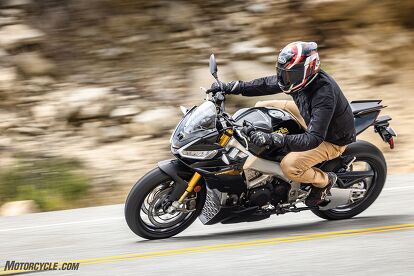
- Helmet: Arai Contour-X Snake
- Jacket: Alpinestars Solano
- Airbag: Alpinestars Tech-Air 3
- Gloves: Racer Grip II
- Jeans: Rev’It Davis
- Boots: Alpinestars Faster 3 Rideknit Shoes
Troy’s Track Gear

- Helmet: Bell Race Star Flex DLX
- Leathers: Alpinestars GP Force Chaser
- Airbag: Alpinestars Tech-Air 5
- Gloves: Alpinestars GP Pro R3
- Boots: Alpinestars Supertech R
Specifications | 2023 Aprilia Tuono V4 Factory 1100 (Stock) | 2022 Yamaha MT-10 SP (Modified) |
|---|---|---|
MSRP | $19,599 | $17,919 (as tested) |
Engine Type | 1077cc, longitudinal 65° V-4 cylinder, 4-stroke, liquid-cooled, double overhead camshafts (DOHC), Four valves per cylinder | 998cc, liquid-cooled DOHC inline 4-cylinder; 16 valves |
Bore x Stroke | 81 mm x 52.3 mm | 79.0 mm x 50.9 mm |
Compression Ratio | 13.6:1 | 12.0:1 |
Power | 156.1 hp at 11,200 rpm (measured) | 141.5 hp @ 11,100 rpm (measured) |
Torque | 84.0 lb-ft. at 8,800 rpm (measured) | 75.0 lb-ft @ 8900 rpm (measured) |
Fuel System | 4 Weber-Marelli 48-mm throttle bodies with 4 injectors and full Ride-By-Wire multimap engine management. | Fuel injection with YCC-T |
Transmission | 6-speed extractable with Aprilia Quick Shift (AQS). | 6-speed; wet multiplate assist and slipper clutch |
Final Drive | Chain | Chain |
Frame | Aluminum dual beam chassis with pressed and cast sheet elements. Adjustments foreseen: position and angle of the headstock, engine height, swingarm pivot height. Smart EC 2.0 electronically managed Öhlins steering damper | Cast aluminum Deltabox |
Front Suspension | Smart EC 2.0 electronically managed Öhlins NIX fork with TIN surface treatment. Wheel travel: 4.7 in. | 43mm Öhlins electronically controlled suspension, fully adjustable; 4.7-in travel |
Rear Suspension | Upside-down double braced aluminum swingarm; Öhlins piggyback monoshock with Smart EC 2.0 electronic control. Wheel travel 5.1 in. | Öhlins electronically controlled suspension, fully adjustable; 4.7-in travel |
Front Brake | 330 mm diameter floating double disc. Brembo M50 monobloc radial calipers with 4 Ø30mm opposing pistons. Radial pump and metal braided brake lines | Dual 320mm EBC wave rotors w/EBC GPFAX pads, metal brake lines, ABS |
Rear Brake | 220 mm diameter disc; Brembo floating caliper with two Ø 32 mm isolated pistons. Pump with built-in tank and metal braided tube | 220mm hydraulic disc; ABS |
Front Wheel | Aluminum alloy cast wheel rim frt: 3.5” X 17” | Cast aluminum 3.5" x 17" |
Rear Wheel | Cast aluminum alloy wheel rim 6.0"x17" | Cast aluminum 6.0" x 17" |
Front Tire | 120/70 ZR 17 | 120/70 ZR 17 |
Rear Tire | 200/55 ZR 17; alternative 190/50 | 190/55 ZR 17 (200/55 ZR 17 as tested) |
Rake/Trail | 24.8° / 3.9 inches | 24° / 4.0 inches |
Wheelbase | 57.2 in. (1,452.4 mm) | 55.3 in. (1,404.6 mm) |
Seat Height | 32.5 inches | 32.9 inches |
Length | 81.5 inches | 82.7 inches |
Overall Width | 31.9 in. (810 mm) | 31.5 inches (800 mm) |
Overall Height | NA | 45.9 inches |
Fuel Capacity | 4.75 gallons | 4.5 gallons |
Curb Weight | 460 pounds (claimed) | 472 pounds (stock, before mods) |
Electronic Aids | APRC system (Aprilia Performance Ride Control) that includes engine maps (AEM), engine brake control (AEB), traction control (ATC), wheelie control (AWC), launch control (ALC), cruise control (ACC), speed limiter (APT). 6 riding modes (3 Road, 3 Track) | Advanced Quick Shift System (QSS), Advanced Ride-By-Wire Throttle with APSG, Cruise Control System, Four-Mode Yamaha Ride Control (YRC), 4.2-Inch Full-Color TFT Display, Six-Axis IMU, Yamaha Variable Speed Limiter (YVSL), Lean sensitive traction control, Slide control system, Front wheel lift control, Engine brake management, Brake control system, lean sensitive ABS |
Colors | Ultra Dark, Time Attack | Liquid Metal/Raven |
We are committed to finding, researching, and recommending the best products. We earn commissions from purchases you make using the retail links in our product reviews. Learn more about how this works.
Become a Motorcycle.com insider. Get the latest motorcycle news first by subscribing to our newsletter here.

Troy's been riding motorcycles and writing about them since 2006, getting his start at Rider Magazine. From there, he moved to Sport Rider Magazine before finally landing at Motorcycle.com in 2011. A lifelong gearhead who didn't fully immerse himself in motorcycles until his teenage years, Troy's interests have always been in technology, performance, and going fast. Naturally, racing was the perfect avenue to combine all three. Troy has been racing nearly as long as he's been riding and has competed at the AMA national level. He's also won multiple club races throughout the country, culminating in a Utah Sport Bike Association championship in 2011. He has been invited as a guest instructor for the Yamaha Champions Riding School, and when he's not out riding, he's either wrenching on bikes or watching MotoGP.
More by Troy Siahaan



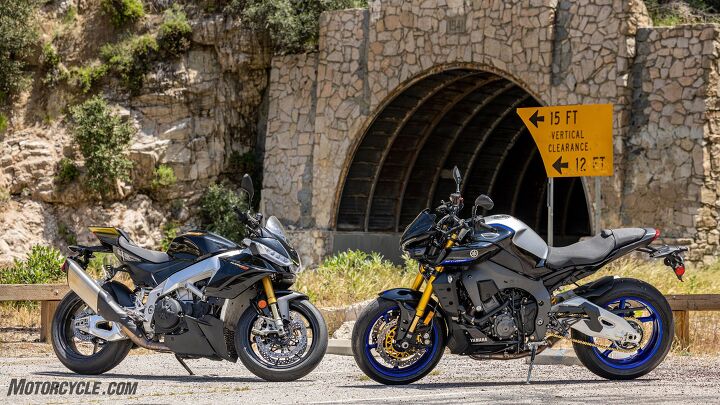







































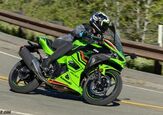


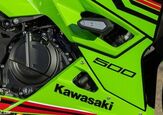
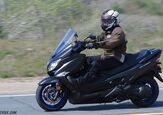
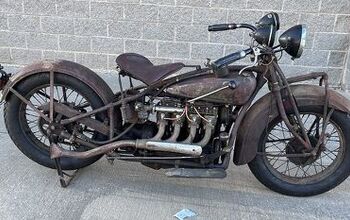
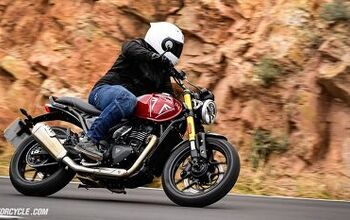
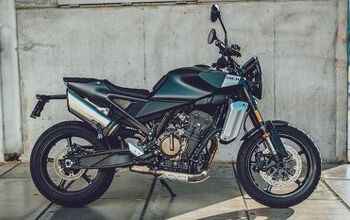
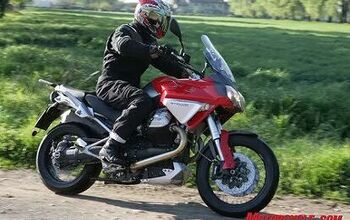
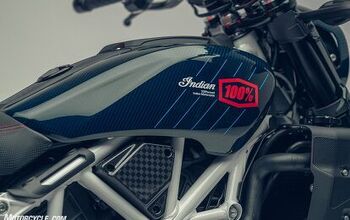
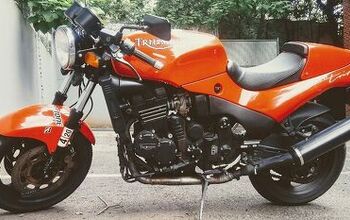
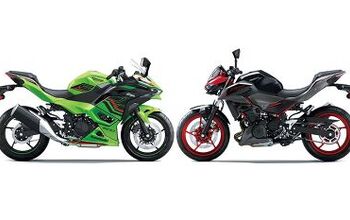
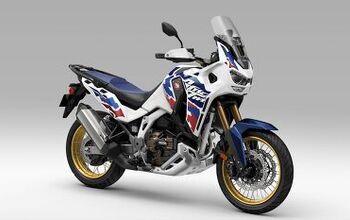

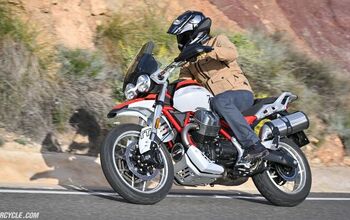
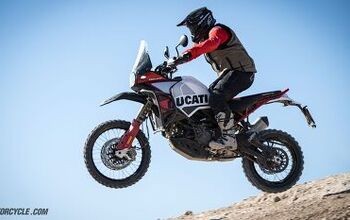

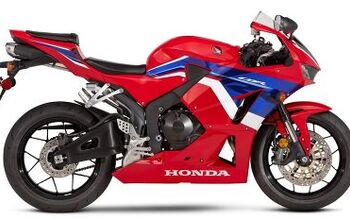
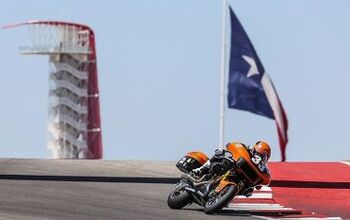
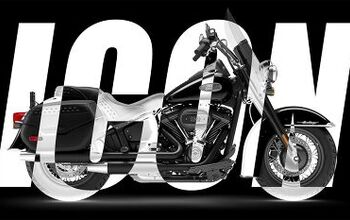

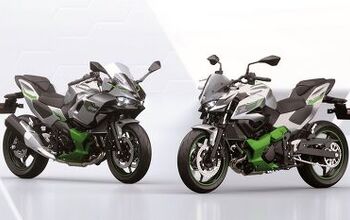
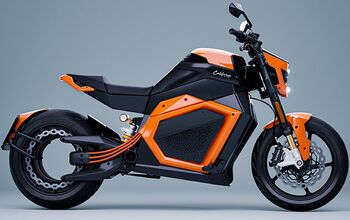
Comments
Join the conversation
an exhaust plus all those other mods for a $1000? lol I'd like to see those receipts.
This is a fantastic project! Most journal outlets review bikes in stock form (which can be helpful to establish a baseline) but this was a fantastic exercise because it addresses the question that many real-world users have - how does the MT10 compare with a few simple mods.
I have been debating this exact scenario and you have answered my question! This deserves a video IMO.